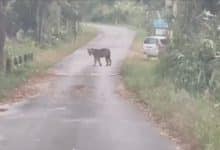Koh Taen locals oppose inclusion in new national park plan

Koh Taen island locals, situated in the Koh Samui district, handed in a petition yesterday in opposition to the Department of National Parks, Wildlife, and Plant Conservation’s (DNP) plan. The proposal is to include the island, along with its neighbouring area, in the soon-to-be-established Hat Khanom-Mu Koh Thale Tai National Park. This has sparked controversy among the locals, who point out that the island has an already established community dating back over 200 years.
The district chief, Kampanat Klinsaowakon, received the petition from Thanakom Ruenpanich, the leader of the Rak Koh Taen Club, who was accompanied by a delegation of 58 locals. The letter, which was addressed to Prime Minister Srettha Thavisin, demanded the cancellation of the island’s inclusion in the national park.
According to Thanakom, Koh Taen is home to at least 300 locals who mainly work in coconut plantations and the fisheries industry. The island not only houses a school, hospital, and monastery but also boasts a rich biodiversity that attracts many conservationists. Its highlights include a coral reef and a mangrove forest.
The government has reportedly approved plans to install submarine electronic cables on the island. However, the DNP’s proposal to incorporate the island’s land and waters, extending at least three nautical miles around the island, as well as ten neighbouring isles in tambon Taling Ngam into the national park, has been met with resistance.
The locals argue that this would create issues related to environmental preservation and their livelihoods, as many rely on income earned from working in these areas. They further claim that certain areas – Koh Taen, Koh Rab, and Koh Mudsum – have land deeds attached to local plantations, rendering their inclusion unnecessary, reported Bangkok Post.
Thanakom added that the proposal would also impact the submarine cable project aimed at bringing electricity from the mainland. Despite the controversy, the national park posted on Facebook that the DNP had already excluded 73,197 rai out of the 197,614 rai of the park’s potential area since the project commenced in 1990.
Latest Thailand News
Follow The Thaiger on Google News:


























